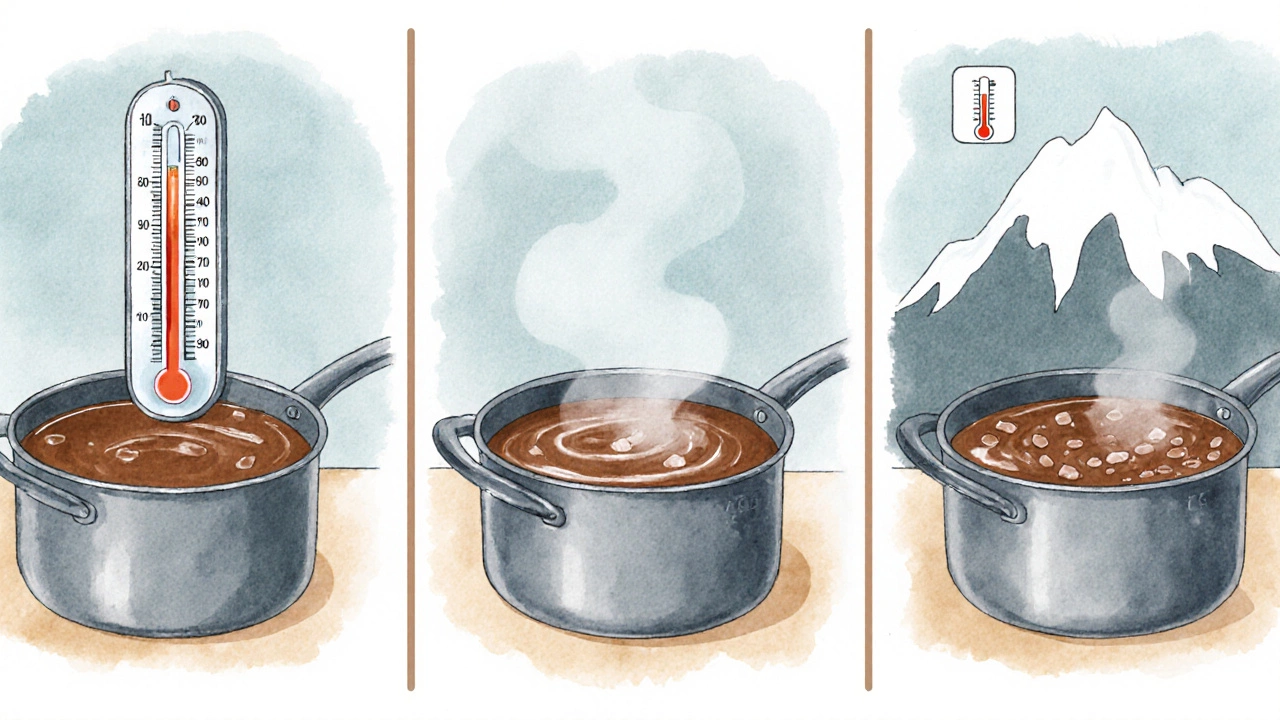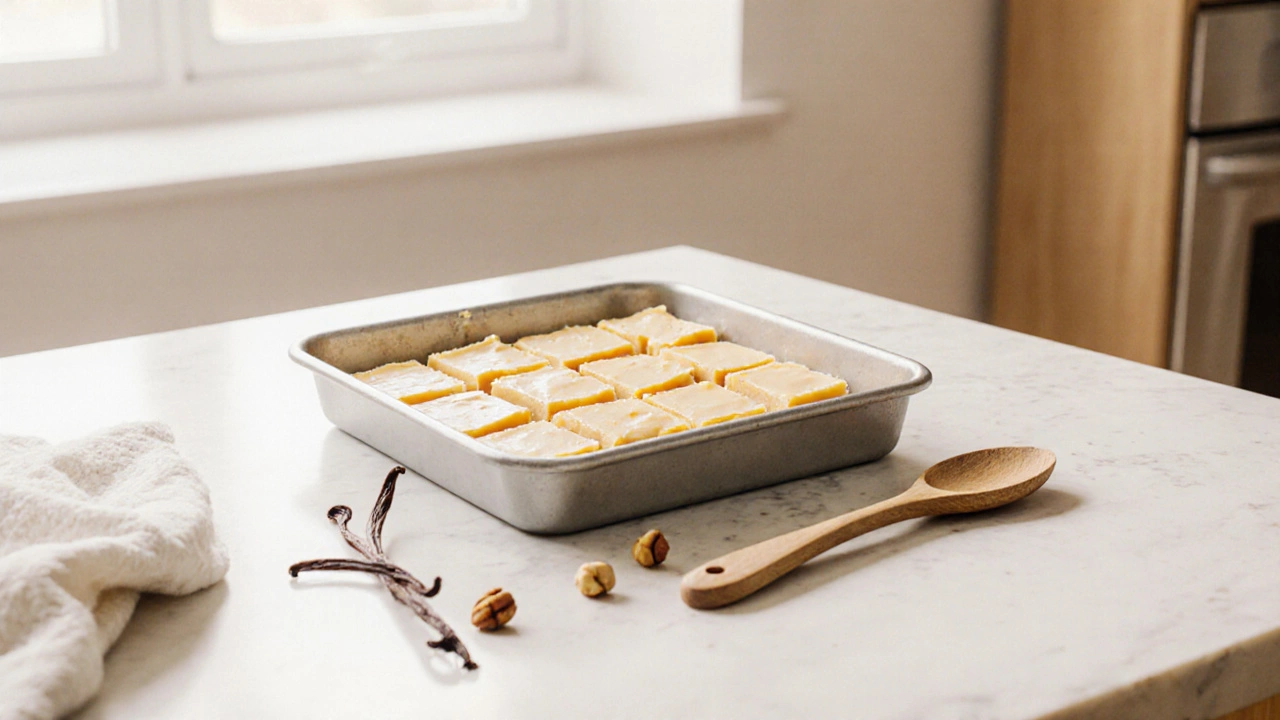Fudge Hardening Calculator
Fudge Hardening Calculator
Adjust for altitude and humidity to hit the perfect soft-ball stage (235-240°F) for firm fudge.
Quick Takeaways
- Use a candy thermometer and hit the "soft‑ball" stage (around 235‑240°F/112‑115°C).
- Stir aggressively once the mixture cools to break up large crystals.
- Control humidity, altitude, and ingredient ratios for reliable set.
- If fudge stays soft, reheating to the proper temperature and a second cool‑beat can rescue it.
- Small recipe tweaks (more butter, less milk) can prevent future soft batches.
Ever pulled a tray of Fudge is a soft, dense confection made by heating sugar, butter, and milk to a precise temperature and then cooling it so sugar crystals form out of the pan, only to find it still pliable a day later? You’re not alone. Below is a no‑nonsense walk‑through of why the classic recipe sometimes refuses to harden and what you can do about it.
What Makes Fudge Harden?
Fudge’s texture hinges on three scientific steps:
- Heating: Dissolve Sugar is a a sweet carbohydrate that, when heated with liquid, dissolves and later recrystallizes to give structure and other solids into a syrup.
- Cooling: Bring the syrup down to a temperature where sugar crystals begin to form-this is called the "soft‑ball" stage.
- Beating: Stir the cooling mixture vigorously. The action breaks larger crystals into millions of tiny ones, creating that smooth, firm bite.
If any of these steps is off, the end result stays glossy and pliable.

Top Reasons Your Fudge Stays Soft
| Issue | Why It Happens | Fix |
|---|---|---|
| Undercooked syrup | Temperature never reached soft‑ball stage. | Use a candy thermometer; heat to 235‑240°F (112‑115°C). |
| Too much liquid | Excess milk or cream dilutes the sugar concentration. | Reduce milk by ¼ cup or add an extra tablespoon of butter. |
| High humidity | Moist air adds water to the surface, preventing crystal set. | Make fudge on dry days or use a dehumidifier; cover pan with foil while cooling. |
| Altitude above 3,000ft | Water boils at lower temps, so you never reach true soft‑ball stage. | Increase target temperature by 5‑10°F (3‑6°C) and reduce liquid slightly. |
| Insufficient beating | Large crystals stay intact, keeping fudge soft. | Stir with a wooden spoon until the mixture loses its shine and thickens. |
Measuring Temperature the Right Way
Relying on “look‑and‑feel” can be risky, especially when kitchen temps fluctuate. A candy thermometer is a a heat‑resistant instrument designed to read high temperatures accurately, typically up to 400°F (204°C) removes guesswork.
- Calibrate first: Drop it into ice water; it should read 32°F (0°C). Adjust if needed.
- Clip it to the pan so the bulb stays submerged but not touching the bottom.
- Watch for the soft‑ball range: 235‑240°F (112‑115°C). Once you hit it, remove from heat immediately.
If you don’t have a thermometer, the “cold‑water test” can work: drop a tiny amount of syrup into a glass of ice water. If it forms a soft, flexible ball that you can roll between your fingers, you’re there.
Quick Fixes When Fudge Refuses to Set
Don’t toss the batch; try one of these rescues.
- Re‑heat and re‑test: Return the mixture to the stove, bring it back to the soft‑ball stage, then let it cool and beat again.
- Add a bit more butter: Butter raises the fat content, which can help the mixture firm up once it cools.
- Introduce corn syrup: A tablespoon of light corn syrup interferes with crystal growth, giving a smoother set.
- Freeze briefly: Place the pan in the freezer for 10‑15 minutes, then stir. This can force crystals to form faster.
- Use the “beat‑and‑fold” method: Transfer the cooled fudge to a stand‑mix bowl and beat with an electric mixer for 2‑3 minutes to create finer crystals.

Prevention: Setting Yourself Up for Success
Implement these habits the next time you whisk up a batch.
- Measure ingredients by weight, not volume. A digital kitchen scale eliminates the guesswork.
- Choose the right cookware: A heavy‑bottomed saucepan distributes heat evenly, reducing hot spots that can scorch sugar.
- Mind the environment: On humid days, pre‑dry your pan with a paper towel, and consider adding a pinch of salt-it lowers the water activity.
- Control altitude: If you live above sea level, increase the target temperature by roughly 5°F (3°C) per 1,000ft.
- Don’t over‑beat after the fudge has cooled past the point where it’s still glossy; over‑mixing can turn it grainy.
Simple, Reliable Fudge Recipe (Baseline)
This recipe follows the classic ratio and serves as a control for troubleshooting.
- Combine Sugar (2 cups), Butter is a a dairy fat that adds richness and helps inhibit large crystal formation (½ cup), and Milk is a a liquid dairy component that provides moisture and contributes to the syrup's consistency (½ cup) in a heavy saucepan.
- Heat over medium, stirring until sugar dissolves. Clip a candy thermometer to the side.
- Bring the mixture to a rolling boil; then stop stirring and watch the thermometer.
- When it reaches 235‑240°F (112‑115°C), remove from heat.
- Let it sit without stirring until it cools to about 110°F (43°C). This cooling window is where crystal size is set.
- Stir vigorously with a wooden spoon until the mixture loses its gloss and thickens-about 2‑3 minutes.
- Fold in 1 tsp of vanilla extract and any add‑ins (nuts, dried fruit, etc.).
- Pour into a greased 8×8‑inch pan, smooth the top, and let it cool completely at room temperature.
Follow the troubleshooting steps above if the final product stays soft. Adjust one variable at a time-temperature, moisture, or beating-to pinpoint the culprit.
Frequently Asked Questions
Why does my fudge melt when I store it in the fridge?
Fudge that hasn’t fully set still contains too much liquid. In the fridge, the cold temperature can cause the sugar to re‑dissolve, making it appear mushy. Re‑heat to the soft‑ball stage, beat again, and ensure the mixture reaches a proper set before refrigerating.
Can I use honey instead of sugar?
Honey adds extra moisture and changes the crystallization pattern, often leaving fudge soft. If you substitute, reduce the added liquid by about ¼ cup and increase the cooking temperature by 5‑10°F.
Is a silicone mat okay for setting fudge?
Yes, a silicone baking mat provides a non‑stick surface and helps regulate cooling. Just make sure the mat is level so the fudge cools uniformly.
My kitchen is humid. Should I add more sugar?
Instead of adding more sugar, which makes the fudge too sweet, reduce the amount of milk or use a little less liquid overall. You can also bake the fudge in a low‑heat oven (150°F/65°C) for 15 minutes to drive off excess moisture.
Why does my fudge have a grainy texture after it sets?
Graininess means large sugar crystals formed. This usually happens when the syrup was over‑cooked past the soft‑ball stage or when stirring was interrupted too early. Re‑cook to the correct temperature and beat vigorously as it cools.